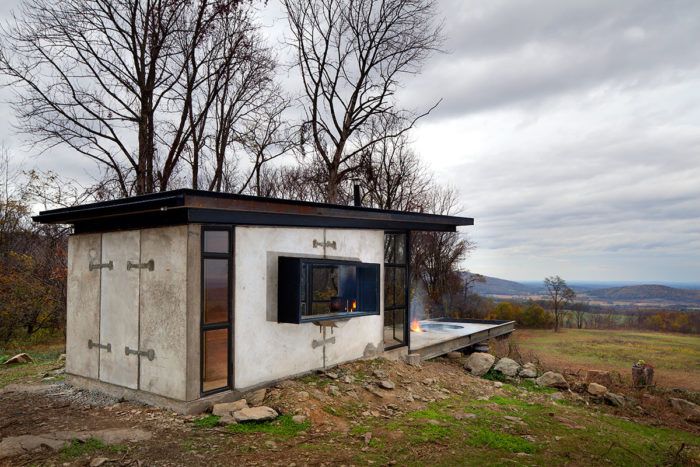The Lost Whiskey Project
GreenSpur’s unconventional cabins accommodate guests looking to unplug from technology and connect to each other.

“This project is like a speakeasy on top of a mountain. . . . It’s about rediscovering the lost art of gathering.”
—Mark Turner, principal
Minimalist in style, GreenSpur’s Lost Whiskey Cabin has a strongly Scandinavian aesthetic. The 160-sq.-ft. off-grid pre-fab concrete structure sits atop a rocky outcropping overlooking Virginia’s wine country. It is the first completed structure in a series that will include three more cabins, a lodge, and a brick-barn whiskey distillery. The idea is to design a place devoted to the enjoyment of life’s simpler pleasures. “The Lost Whiskey Project is about exploring our personal limits of slowing down and simplifying,” explains GreenSpur principal Mark Turner.
The flat-packed concrete tilt-up structure was prebuilt in the GreenSpur warehouse and features a number of uncomplicated technologies. The off-grid low-amperage cabin runs solely on a 12-volt system modeled after a sailboat’s electronics. For temperature control, they added a large overhang above the south-facing windows and ran earth tubes under the slab to feed below-grade air into the living quarters. The mass of concrete also helps to keep the cabin cool, as does the roof, which is constructed of structural insulated panels (SIPs) with 10 1/2-in.-thick EPS foam. In winter, a small wood-fired stove keeps the interior warm. “Once the concrete heats up, it stays T-shirt comfortable in the dead of winter,” says Turner, noting that the slab floor makes slippers a good idea.
Gutter water collects in a cistern made from a 2 ft. by x 10 ft. culvert pipe tipped on its end. The Dutch tub was made from a horse water trough and is heated by the fire pit. Turner connected 1 1/2 in. copper lines—one high and one low—from the tub to a coil that wraps around the inside of the fire pit, so as the fire heats the coil the water convects. It takes about three hours to reach the desirable temperature for a piping-hot soak.
Accommodations include a shower, a composting toilet, a propane cooktop, a wide-net hammock suspended over the cliff side, and a murphy bed, which closes to offer a dining table for up to six people. All told, the cabin is nearly maintenance-free and is predicted to function in 100 years just as it does today.
To get The Lost Whiskey Project brand rolling, GreenSpur sent out an invitation to partake in The Lost Whiskey Challenge—something inspired by the Japanese idea of “forest bathing” and modeled after Sweden’s 72 Hour Challenge. They selected six groups of professionals to stay at the cabin for 48 hours, challenging them to completely unplug. The call for applications included the line: “You may go crazy, you may not. Either way, you will have a story to tell—and that is what we are interested in.”
In the spirit of whiskey-fueled storytelling, the GreenSpur team is set to launch a podcast meant to inspire genuine connection. “We think the ability to pause, reflect, and get lost in our own thoughts or conversation makes for a good modern-day tale,” says Turner, who predicts the first episode will air late September.
Photos by Mitch Allen/Mitch Allen Photography, courtesy of GreenSpur
Fine Homebuilding Recommended Products
Fine Homebuilding receives a commission for items purchased through links on this site, including Amazon Associates and other affiliate advertising programs.

The New Carbon Architecture: Building to Cool the Climate

A House Needs to Breathe...Or Does It?: An Introduction to Building Science

A Field Guide to American Houses





































